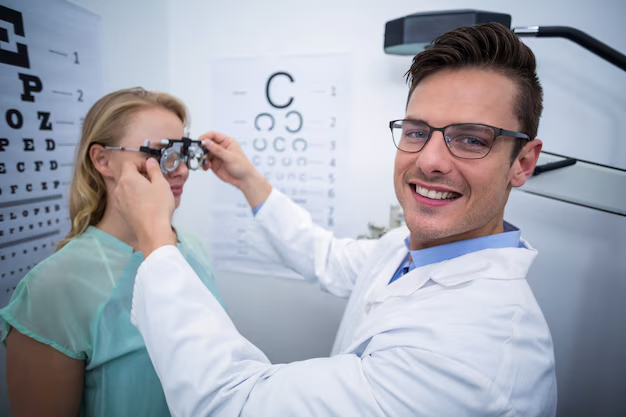Can Cataracts Lead to Blurry Vision? Understanding the Connection
Imagine the world appears as though you're looking through a foggy lens—colors lose their vibrance, details blur, and what was once clear becomes frustratingly obscure. For many, these experiences can be linked to cataracts, a common eye condition. But do cataracts cause blurry vision? Let's explore this question from multiple perspectives to understand how cataracts impact your sight, how they develop, and what you can do if you experience these symptoms.
🤔 What Are Cataracts?
Cataracts are a clouding of the eye's natural lens, situated behind the iris and pupil. As we age, proteins in the lens can clump together, forming cloudy areas that can grow over time, impacting how light passes through the lens. This can significantly affect vision quality, leading to blurry vision and other symptoms.
Types of Cataracts
- Nuclear Cataracts: Typically associated with aging, these form in the center of the lens and can cause the lens to turn yellow or even brown.
- Cortical Cataracts: Known for creating whitish, wedge-like opacities that start at the lens's edge and move towards the center.
- Posterior Subcapsular Cataracts: Develop more rapidly and create opacity at the back of the lens, often affecting near vision and causing glare.
- Congenital Cataracts: Present at birth or developing during childhood, these cataracts can sometimes have less impact on vision.
Do Cataracts Cause Blurry Vision?
Blurry vision is one of the most common and early symptoms associated with cataracts. The cloudiness in the lens scatters light, preventing a sharply defined image from reaching the retina. This results in vision that might feel similar to looking through a frosted window.
How Cataracts Affect Vision
- Reduced Clarity: As cataracts progress, vision becomes increasingly foggy.
- Color Changes: Objects may appear duller than before, and colors might not seem as bright.
- Difficulty with Night Vision: Cataracts can make it hard to see clearly in low-light conditions.
- Increased Sensitivity to Glare: People often find bright lights or sunlight excessively glaring, and halos can appear around lights.
- Frequent Prescription Changes: You might need changes to vision prescription more often as cataracts develop.
🌟 Key Takeaways: Recognizing Cataract Symptoms
Here are some practical tips and signs that can indicate cataract development:
- 👓 Blurry or Clouded Vision: A clear indicator, particularly if it worsens over time.
- 🌈 Faded Colors: Pay attention if colors you see daily start to seem dull.
- 🌞 Increased Glare Sensitivity: If bright lights become uncomfortably glaring.
- 🌛 Night Vision Issues: Challenges with seeing clearly in dim lighting or at night.
- 📅 Frequent Changes in Prescription: Needing adjustments more often could be a sign.
Who Is at Risk?
Anyone can develop cataracts, but certain factors can increase risk:
- Age: Most commonly develop in adults over 40, becoming more prevalent as you age.
- Genetics: Family history can play a significant role.
- Lifestyle Choices: Smoking, excessive alcohol use, and poor diet may enhance risk.
- Medical Conditions: Diabetes increases the likelihood of developing cataracts.
- Previous Eye Injuries or Surgery: History of eye trauma or surgery can contribute.
How Are Cataracts Diagnosed?
A comprehensive eye exam is crucial. During this, an eye specialist may conduct:
- Visual Acuity Test: Measures how clear your vision is.
- Slit-Lamp Examination: Uses a bright light and microscope to examine eye structures closely.
- Retinal Exam: Dilating the pupils to inspect the back of your eyes.
When to See an Eye Specialist
If you notice any changes in vision, especially if symptoms progress quickly or are severe, consulting an eye care professional is advised. They can offer detailed insights into eye health and discuss potential treatment options.
Treatment Options for Cataracts
While lifestyle adjustments and prescription lenses can help manage early symptoms, advanced cataracts often require surgery.
Cataract Surgery
- Standard Cataract Surgery: Removing the clouded lens and replacing it with an artificial intraocular lens (IOL).
- Laser-Assisted Cataract Surgery: Uses laser technology for more precise incisions and lends replacement.
Both options are typically safe, routine procedures that can restore clarity and significantly improve quality of life. However, surgery is generally considered when cataracts begin to notably hinder daily activities.
👁️ Cataract Prevention Tips
Taking proactive steps can help delay cataract development:
- 🕶️ Wear Sunglasses: Protects eyes from harmful UV rays.
- 🚭 Quit Smoking: Reduces risk factors associated with cataract development.
- 🍽️ Balanced Diet: Focus on antioxidants like vitamins C and E found in fruits and vegetables to support eye health.
- 🍷 Limit Alcohol Consumption: Helps minimize potential eye health impacts.
- 🏃 Regular Eye Exams: Early detection can slow progression and improve outcomes.
Living with Cataracts
Managing life with cataracts involves lifestyle tweaks and being vigilant about eye health.
Practical Adjustments
- Increase Lighting: Use brighter lights at home for better visibility.
- Use Magnifying Glasses: Enhance reading or detailed work.
- Avoid Driving at Night: Especially if night vision is significantly impaired.
Conclusion: Navigating Blurry Vision and Cataracts
As we have explored, cataracts can indeed cause blurry vision along with a suite of other symptoms that can affect daily life. Understanding specific signs and taking preventive measures are vital for maintaining eye health. If you're experiencing changes in your vision, consulting with an eye care professional can offer clarity and guide you on the best path forward. Remember, while cataracts can be a normal part of aging, managing them effectively can lead to continued clarity and quality of life.
